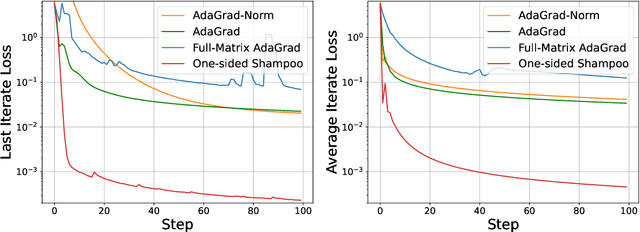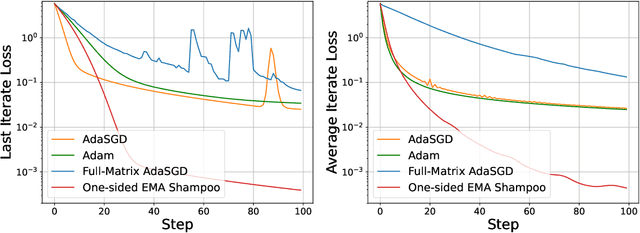Zhiyuan Li
Kimi Linear: An Expressive, Efficient Attention Architecture
Oct 30, 2025Abstract:We introduce Kimi Linear, a hybrid linear attention architecture that, for the first time, outperforms full attention under fair comparisons across various scenarios -- including short-context, long-context, and reinforcement learning (RL) scaling regimes. At its core lies Kimi Delta Attention (KDA), an expressive linear attention module that extends Gated DeltaNet with a finer-grained gating mechanism, enabling more effective use of limited finite-state RNN memory. Our bespoke chunkwise algorithm achieves high hardware efficiency through a specialized variant of the Diagonal-Plus-Low-Rank (DPLR) transition matrices, which substantially reduces computation compared to the general DPLR formulation while remaining more consistent with the classical delta rule. We pretrain a Kimi Linear model with 3B activated parameters and 48B total parameters, based on a layerwise hybrid of KDA and Multi-Head Latent Attention (MLA). Our experiments show that with an identical training recipe, Kimi Linear outperforms full MLA with a sizeable margin across all evaluated tasks, while reducing KV cache usage by up to 75% and achieving up to 6 times decoding throughput for a 1M context. These results demonstrate that Kimi Linear can be a drop-in replacement for full attention architectures with superior performance and efficiency, including tasks with longer input and output lengths. To support further research, we open-source the KDA kernel and vLLM implementations, and release the pre-trained and instruction-tuned model checkpoints.
DP-FedLoRA: Privacy-Enhanced Federated Fine-Tuning for On-Device Large Language Models
Sep 11, 2025Abstract:As on-device large language model (LLM) systems become increasingly prevalent, federated fine-tuning enables advanced language understanding and generation directly on edge devices; however, it also involves processing sensitive, user-specific data, raising significant privacy concerns within the federated learning framework. To address these challenges, we propose DP-FedLoRA, a privacy-enhanced federated fine-tuning framework that integrates LoRA-based adaptation with differential privacy in a communication-efficient setting. Each client locally clips and perturbs its LoRA matrices using Gaussian noise to satisfy ($\epsilon$, $\delta$)-differential privacy. We further provide a theoretical analysis demonstrating the unbiased nature of the updates and deriving bounds on the variance introduced by noise, offering practical guidance for privacy-budget calibration. Experimental results across mainstream benchmarks show that DP-FedLoRA delivers competitive performance while offering strong privacy guarantees, paving the way for scalable and privacy-preserving LLM deployment in on-device environments.
Megrez2 Technical Report
Jul 23, 2025Abstract:We present Megrez2, a novel lightweight and high-performance language model architecture optimized for device native deployment. Megrez2 introduces a novel cross-layer expert sharing mechanism, which significantly reduces total parameter count by reusing expert modules across adjacent transformer layers while maintaining most of the model's capacity. It also incorporates pre-gated routing, enabling memory-efficient expert loading and faster inference. As the first instantiation of the Megrez2 architecture, we introduce the Megrez2-Preview model, which is pre-trained on a 5-trillion-token corpus and further enhanced through supervised fine-tuning and reinforcement learning with verifiable rewards. With only 3B activated and 7.5B stored parameters, Megrez2-Preview demonstrates competitive or superior performance compared to larger models on a wide range of tasks, including language understanding, instruction following, mathematical reasoning, and code generation. These results highlight the effectiveness of the Megrez2 architecture to achieve a balance between accuracy, efficiency, and deployability, making it a strong candidate for real-world, resource-constrained applications.
A Survey of Retentive Network
Jun 07, 2025Abstract:Retentive Network (RetNet) represents a significant advancement in neural network architecture, offering an efficient alternative to the Transformer. While Transformers rely on self-attention to model dependencies, they suffer from high memory costs and limited scalability when handling long sequences due to their quadratic complexity. To mitigate these limitations, RetNet introduces a retention mechanism that unifies the inductive bias of recurrence with the global dependency modeling of attention. This mechanism enables linear-time inference, facilitates efficient modeling of extended contexts, and remains compatible with fully parallelizable training pipelines. RetNet has garnered significant research interest due to its consistently demonstrated cross-domain effectiveness, achieving robust performance across machine learning paradigms including natural language processing, speech recognition, and time-series analysis. However, a comprehensive review of RetNet is still missing from the current literature. This paper aims to fill that gap by offering the first detailed survey of the RetNet architecture, its key innovations, and its diverse applications. We also explore the main challenges associated with RetNet and propose future research directions to support its continued advancement in both academic research and practical deployment.
THINK-Bench: Evaluating Thinking Efficiency and Chain-of-Thought Quality of Large Reasoning Models
May 28, 2025Abstract:Large reasoning models (LRMs) have achieved impressive performance in complex tasks, often outperforming conventional large language models (LLMs). However, the prevalent issue of overthinking severely limits their computational efficiency. Overthinking occurs when models generate excessive and redundant tokens that contribute little to accurate outcomes, especially in simple tasks, resulting in a significant waste of computational resources. To systematically investigate this issue, we introduce Think-Bench, a benchmark designed to evaluate the reasoning efficiency of LRMs. We also propose novel efficiency metrics and conduct a comprehensive evaluation of various LRMs across multiple dimensions, including the reasoning process, outcome quality, and chain-of-thought (CoT) characteristics. Our analysis reveals that most LRMs exhibit overthinking in handling easy questions, generating unnecessarily lengthy reasoning chains. While many LRMs demonstrate high CoT quality, several suffer from low efficiency. We hope that Think-Bench can serve as a robust foundation for advancing research into LRMs.
On Learning Verifiers for Chain-of-Thought Reasoning
May 28, 2025Abstract:Chain-of-Thought reasoning has emerged as a powerful approach for solving complex mathematical and logical problems. However, it can often veer off track through incorrect or unsubstantiated inferences. Formal mathematical reasoning, which can be checked with a formal verifier, is one approach to addressing this issue. However, currently LLMs are simply not good enough to solve complex problems in a formal way, and even just formalizing an informal problem statement can be challenging. Motivated by this fact, in this work we consider the problem of learning reliable verifiers for natural language Chain-of-Thought reasoning. That is, given a problem statement and step-by-step solution in natural language, the aim of the verifier is to output [Yes] if the reasoning steps in the solution are all valid, and [No] otherwise. In this work we give a formal PAC-learning framework for studying this problem. We propose and analyze several natural verification goals, at different levels of strength, in this framework. We provide sample complexity upper-bounds for learning verifiers satisfying these goals, as well as lower-bound and impossibility results for learning other natural verification objectives without additional assumptions.
UWSAM: Segment Anything Model Guided Underwater Instance Segmentation and A Large-scale Benchmark Dataset
May 21, 2025Abstract:With recent breakthroughs in large-scale modeling, the Segment Anything Model (SAM) has demonstrated significant potential in a variety of visual applications. However, due to the lack of underwater domain expertise, SAM and its variants face performance limitations in end-to-end underwater instance segmentation tasks, while their higher computational requirements further hinder their application in underwater scenarios. To address this challenge, we propose a large-scale underwater instance segmentation dataset, UIIS10K, which includes 10,048 images with pixel-level annotations for 10 categories. Then, we introduce UWSAM, an efficient model designed for automatic and accurate segmentation of underwater instances. UWSAM efficiently distills knowledge from the SAM ViT-Huge image encoder into the smaller ViT-Small image encoder via the Mask GAT-based Underwater Knowledge Distillation (MG-UKD) method for effective visual representation learning. Furthermore, we design an End-to-end Underwater Prompt Generator (EUPG) for UWSAM, which automatically generates underwater prompts instead of explicitly providing foreground points or boxes as prompts, thus enabling the network to locate underwater instances accurately for efficient segmentation. Comprehensive experimental results show that our model is effective, achieving significant performance improvements over state-of-the-art methods on multiple underwater instance datasets. Datasets and codes are available at https://github.com/LiamLian0727/UIIS10K.
PENCIL: Long Thoughts with Short Memory
Mar 18, 2025



Abstract:While recent works (e.g. o1, DeepSeek R1) have demonstrated great promise of using long Chain-of-Thought (CoT) to improve reasoning capabilities of language models, scaling it up during test-time is challenging due to inefficient memory usage -- intermediate computations accumulate indefinitely in context even no longer needed for future thoughts. We propose PENCIL, which incorporates a reduction mechanism into the autoregressive generation process, allowing the model to recursively clean up intermediate thoughts based on patterns learned from training. With this reduction mechanism, PENCIL significantly reduces the maximal context length required during generation, and thus can generate longer thoughts with limited memory, solving larger-scale problems given more thinking time. For example, we demonstrate PENCIL achieves 97\% accuracy on the challenging Einstein's puzzle -- a task even large models like GPT-4 struggle with -- using only a small 25M-parameter transformer with 2048 context length. Theoretically, we prove PENCIL can perform universal space-efficient computation by simulating Turing machines with optimal time and space complexity, and thus can solve arbitrary computational tasks that would otherwise be intractable given context window constraints.
Structured Preconditioners in Adaptive Optimization: A Unified Analysis
Mar 13, 2025



Abstract:We present a novel unified analysis for a broad class of adaptive optimization algorithms with structured (e.g., layerwise, diagonal, and kronecker-factored) preconditioners for both online regret minimization and offline convex optimization. Our analysis not only provides matching rate to several important structured preconditioned algorithms including diagonal AdaGrad, full-matrix AdaGrad, and AdaGrad-Norm, but also gives an improved convergence rate for a one-sided variant of Shampoo over that of original Shampoo. Interestingly, more structured preconditioners (e.g., diagonal Adagrad, AdaGrad-Norm which use less space and compute) are often presented as computationally efficient approximations to full-matrix Adagrad, aiming for improved optimization performance through better approximations. Our unified analysis challenges this prevailing view and reveals, perhaps surprisingly, that more structured preconditioners, despite using less space and computation per step, can outperform their less structured counterparts. To demonstrate this, we show that one-sided Shampoo, which is relatively much cheaper than full-matrix AdaGrad could outperform it both theoretically and experimentally.
A Theory of Learning with Autoregressive Chain of Thought
Mar 11, 2025Abstract:For a given base class of sequence-to-next-token generators, we consider learning prompt-to-answer mappings obtained by iterating a fixed, time-invariant generator for multiple steps, thus generating a chain-of-thought, and then taking the final token as the answer. We formalize the learning problems both when the chain-of-thought is observed and when training only on prompt-answer pairs, with the chain-of-thought latent. We analyze the sample and computational complexity both in terms of general properties of the base class (e.g. its VC dimension) and for specific base classes such as linear thresholds. We present a simple base class that allows for universal representability and computationally tractable chain-of-thought learning. Central to our development is that time invariance allows for sample complexity that is independent of the length of the chain-of-thought. Attention arises naturally in our construction.
 Add to Chrome
Add to Chrome Add to Firefox
Add to Firefox Add to Edge
Add to Edge